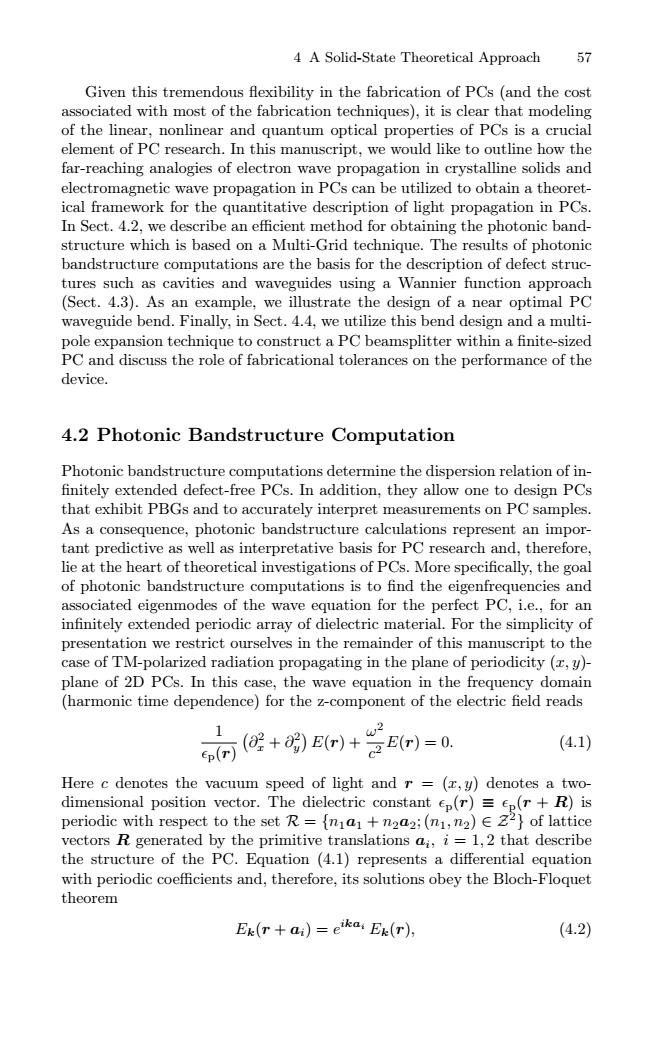正在加载图片...

4 A Solid-State Theoretical Approach 57 Given this tremendous flexibility in the fabrication of PCs(and the cost associated with most of the fabrication techniques),it is clear that modeling of the linear,nonlinear and quantum optical properties of PCs is a crucial element of PC research.In this manuscript,we would like to outline how the far-reaching analogies of electron wave propagation in crystalline solids and electromagnetic wave propagation in PCs can be utilized to obtain a theoret- ical framework for the quantitative description of light propagation in PCs. In Sect.4.2,we describe an efficient method for obtaining the photonic band- structure which is based on a Multi-Grid technique.The results of photonic bandstructure computations are the basis for the description of defect struc- tures such as cavities and waveguides using a Wannier function approach (Sect.4.3).As an example,we illustrate the design of a near optimal PC waveguide bend.Finally,in Sect.4.4,we utilize this bend design and a multi- pole expansion technique to construct a PC beamsplitter within a finite-sized PC and discuss the role of fabricational tolerances on the performance of the device. 4.2 Photonic Bandstructure Computation Photonic bandstructure computations determine the dispersion relation of in- finitely extended defect-free PCs.In addition,they allow one to design PCs that exhibit PBGs and to accurately interpret measurements on PC samples. As a consequence,photonic bandstructure calculations represent an impor- tant predictive as well as interpretative basis for PC research and,therefore, lie at the heart of theoretical investigations of PCs.More specifically,the goal of photonic bandstructure computations is to find the eigenfrequencies and associated eigenmodes of the wave equation for the perfect PC,i.e.,for an infinitely extended periodic array of dielectric material.For the simplicity of presentation we restrict ourselves in the remainder of this manuscript to the case of TM-polarized radiation propagating in the plane of periodicity(,y)- plane of 2D PCs.In this case,the wave equation in the frequency domain (harmonic time dependence)for the z-component of the electric field reads ,而候+))+兰6m=0 1 (4.1) Here c denotes the vacuum speed of light and r=(x,y)denotes a two- dimensional position vector.The dielectric constant ep(r)=ep(r+R)is periodic with respect to the set R={na1+n2a2;(n1,n2)E Z2}of lattice vectors R generated by the primitive translations ai,i=1,2 that describe the structure of the PC.Equation (4.1)represents a differential equation with periodic coefficients and,therefore,its solutions obey the Bloch-Floquet theorem Ek(r+ai)=eika Ek(r), (4.2)4 A Solid-State Theoretical Approach 57 Given this tremendous flexibility in the fabrication of PCs (and the cost associated with most of the fabrication techniques), it is clear that modeling of the linear, nonlinear and quantum optical properties of PCs is a crucial element of PC research. In this manuscript, we would like to outline how the far-reaching analogies of electron wave propagation in crystalline solids and electromagnetic wave propagation in PCs can be utilized to obtain a theoretical framework for the quantitative description of light propagation in PCs. In Sect. 4.2, we describe an efficient method for obtaining the photonic bandstructure which is based on a Multi-Grid technique. The results of photonic bandstructure computations are the basis for the description of defect structures such as cavities and waveguides using a Wannier function approach (Sect. 4.3). As an example, we illustrate the design of a near optimal PC waveguide bend. Finally, in Sect. 4.4, we utilize this bend design and a multipole expansion technique to construct a PC beamsplitter within a finite-sized PC and discuss the role of fabricational tolerances on the performance of the device. 4.2 Photonic Bandstructure Computation Photonic bandstructure computations determine the dispersion relation of in- finitely extended defect-free PCs. In addition, they allow one to design PCs that exhibit PBGs and to accurately interpret measurements on PC samples. As a consequence, photonic bandstructure calculations represent an important predictive as well as interpretative basis for PC research and, therefore, lie at the heart of theoretical investigations of PCs. More specifically, the goal of photonic bandstructure computations is to find the eigenfrequencies and associated eigenmodes of the wave equation for the perfect PC, i.e., for an infinitely extended periodic array of dielectric material. For the simplicity of presentation we restrict ourselves in the remainder of this manuscript to the case of TM-polarized radiation propagating in the plane of periodicity (x, y)- plane of 2D PCs. In this case, the wave equation in the frequency domain (harmonic time dependence) for the z-component of the electric field reads 1 p(r) ∂2 x + ∂2 y E(r) + ω2 c2 E(r)=0. (4.1) Here c denotes the vacuum speed of light and r = (x, y) denotes a twodimensional position vector. The dielectric constant p(r) ≡ p(r + R) is periodic with respect to the set R = {n1a1 + n2a2; (n1, n2) ∈ Z2} of lattice vectors R generated by the primitive translations ai, i = 1, 2 that describe the structure of the PC. Equation (4.1) represents a differential equation with periodic coefficients and, therefore, its solutions obey the Bloch-Floquet theorem Ek(r + ai) = eikai Ek(r), (4.2)